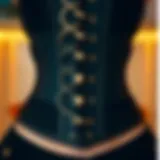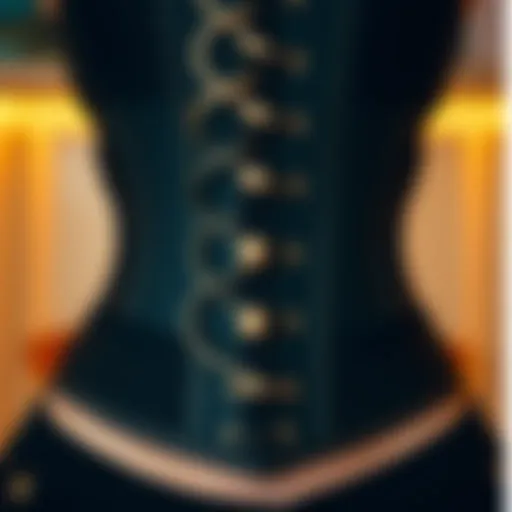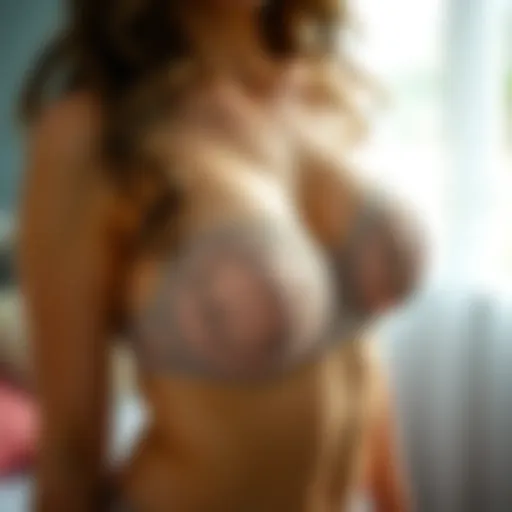Examining Romwe's Role in Modern Fashion Trends
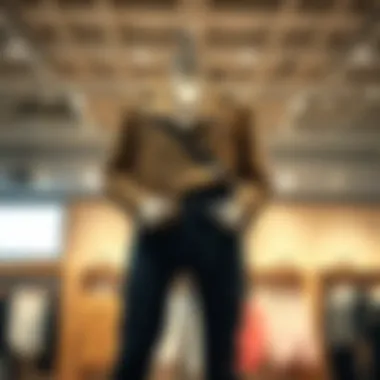

Intro
Romwe has carved out a notable niche in the ever-evolving landscape of online fashion retail. It stands out as a prime example of the fast fashion model, catering to a generation that's constantly on the move and looking for the next big trend. This article will peel back the layers of Romwe, exploring not just its distinct approach to fashion but also how it resonates with modern consumers.
Fast fashion can be likened to a speeding train; it hurtles forward at breakneck pace, and the stops it makes are brief. Romwe embodies this concept perfectly by cycling through trends so quickly, one might wonder if the term 'season' still holds water in this scenario. The brand's ability to keep up with, and often lead, the trends largely hinges on its understanding of its target demographic.
Young adults and teenagers form the backbone of Romwe's audience. They desire style that reflects their individuality without breaking the bank. This exploration will delve deeper into how Romwe marries affordability with current styles, all while addressing the implications of such a model in terms of sustainability.
The article will discuss various aspects including how Romwe engages with its shoppers, from online platforms to social media interactions, and how this builds brand loyalty. Moreover, we'll look into the wider implications for an industry that remains rife with criticisms surrounding fast fashion's environmental toll.
The narrative that follows will weave together insights, analysis, and thought-provoking observations, serving both fashion enthusiasts and industry insiders. As we embark on this journey, we will unravel the complex web that is the modern apparel shopping experience, stitching together the threads of consumer behavior, brand influence, and fashion trends.
Fashion Trends
Latest Seasonal Trends
Romwe is often at the forefront of identifying and capitalizing on current trends. The website is refreshing, showcasing new arrivals weekly, which fuels its appeal. From bold graphic tees to oversized blazers, each season presents a palette that reflects broader societal shifts and cultural influences.
For instance, during the summer months, one might notice a surge in pastel shades and floral patterns as the brand embraces a light, breezy aesthetic. During colder months, earthy tones and knitwear take center stage, catering to comfort while maintaining style. The constantly changing inventory serves as a visual feast for consumers, allowing them to express themselves through fashion in a way that feels fresh and exciting.
Iconic Styles Revived
In addition to presenting new trends, Romwe has a knack for reviving iconic styles. Vintage fashion has been making waves, and Romwe taps into this nostalgia effectively. Think of the re-emergence of high-waisted jeans or the return of flared pants. These pieces not only cater to current tastes but also resonate with a particular appreciation for the past—allowing consumers to blend modern styles with beloved classics.
Noteworthy Revivals:
- Denim jackets with patches and embellishments
- Chunky sneakers reminiscent of 90s grunge
- Tie-dye shirts that echo the carefree spirit of past decades
- Belted coats that provide functionality without sacrificing aesthetics
Romwe effectively combines the new and the old, engaging its shoppers in a conversation about style that extends beyond mere clothing; it evokes memories and sentiments.
With Romwe's fingers on the pulse of fashion, it is clear that the brand's impact reaches further than just sales figures. This section will serve as an essential foundation for understanding its broader implications, including how the fast fashion model is reshaping consumer habits and perceptions.
Sustainability concerns are becoming increasingly prominent, prompting a deeper discussion around the longevity of fast fashion brands in a world crying out for more responsible practices. This vital aspect calls for an examination of Romwe's practices and future trajectory.
Stay tuned as we dig into the heart of fashion tips next, offering practical insights and strategies for blending Romwe pieces into one's own wardrobe, no matter the occasion.
Intro to Romwe Shop
Exploring Romwe Shop is significant for understanding the current trends in online fashion retail. This retailer has established itself as a key player in the fast fashion sphere, catering to a specific demographic while offering an extensive range of products that resonate with contemporary tastes. By examining Romwe's operations, shoppers, and impact, one can gain insights not only into its brand identity but also how it shapes and influences wider fashion trends across the glob.
Overview of Romwe's Brand Identity
Romwe's brand identity is crafted through a sleek online presence and a distinctive approach to fashion. It markets itself as a trendy and affordable option for style-savvy consumers. The essence of Romwe lies in its responsive culture towards the latest fashion trends, catering to young adults who seek variety and affordability.
The target market often consists of those who are constantly on the lookout for fashionable yet budget-friendly apparel. Romwe positions itself as a solution for style seekers who want to express themselves without breaking the bank. The visual aesthetic of their website reflects a modern and youthful vibe, which is designed to appeal to the millennial and Gen Z audiences. Colorful imagery, appealing layouts, and user-friendly navigation are all crucial elements that make shopping a pleasurable experience.
Additionally, Romwe effectively utilizes social media platforms to amplify its brand presence. It engages users by sharing content that showcases its products in relatable and trendy settings. This dynamic interaction helps bridge the gap between consumer desires and the products offered, reinforcing Romwe's commitment to staying on the cutting edge of fashion.
Founding and Evolution
Romwe started as an online retailer looking to bring the latest fashion trends to consumers at affordable prices. Founded in 2009, its evolution reflects the rapid changes within the fashion sector, particularly the increasing inclination towards online shopping. Initially centered on a smaller product range, the brand has expanded significantly over the years, adapting to market needs and the demands of fast fashion.
The founders recognized the shift in shopping behaviors with the rise of the internet and social media. They tapped into a niche market that craved quick access to trendy clothing, and over time, Romwe has become synonymous with fast fashion. The company’s operational model allows for swift response times to emerging fashion trends, ensuring that customers can often find new styles just before they become mainstream.
This evolution has not only helped Romwe solidify its market position but has also influenced competitors to modify their strategies to keep pace. Being adaptable has been crucial for Romwe, and this flexibility in operations is one of the keys to its ongoing success in the ever-volatile world of fashion retail.
As Romwe continues to grow, its foundational elements of affordability and trend responsiveness ensure that it remains relevant amongst its audience, paving the way for future developments within the brand.
Understanding Romwe's Target Market
The understanding of Romwe's target market is crucial for grasping how the brand has carved its niche in the fast fashion landscape. Recognizing the demographics and psychographics of its consumers reveals not just who buys from Romwe, but why they make those purchases. This section aims to dissect these elements, illustrating their significance in shaping Romwe's marketing strategies and product offerings.
Demographic Analysis
Demographic factors serve as the building blocks in understanding Romwe's customer base. Primarily, the brand attracts a young audience, specifically millennials and Gen Z. This age group is not just fashion-savvy, but also values affordability and trendiness. According to various surveys, consumers aged 18-35 often prioritize style over brand-name luxury.
Key demographics include:
- Age: The majority of Romwe's shoppers are between 18 to 30 years old. This age bracket is not only concerned about current fashion trends but is also highly influenced by social media.
- Location: While Romwe operates globally, a significant portion of its sales comes from countries like the United States, Canada, and several parts of Europe and Asia. The accessibility provided by e-commerce makes it easier for these consumers, spread across different geographies, to browse and shop.
- Income Level: Most of Romwe's customers are students or young professionals, usually on a tight budget. They seek to make fashion statements without breaking the bank, which aligns perfectly with Romwe's low-price offerings.
This demographic analysis paints a picture of a vibrant, price-conscious audience, stepping towards fashion with enthusiasm and an eye for social validation.
Psychographic Insights
Delving deeper, psychographic insights provide a lens into the attitudes and lifestyle choices of Romwe's target market. It’s one thing to know who is shopping; it’s another to understand what drives their fashion decisions.
First and foremost, this audience desires authenticity and individuality in their style. Many young consumers are notorious for their strong opinions and willingness to experiment with different looks, wanting their outfits to reflect their personality rather than adhere to existing norms. This quest leads them to brands like Romwe, where diverse options are plentiful.
Moreover, there's an undeniable social connectivity factor. Social media platforms like Instagram and TikTok have spurred on trends at an overwhelming speed, impacting how and why pieces are purchased. The need to stand out online often influences what items fly off the virtual shelves, and Romwe strategically taps into these trends.
In addition, this demographic tends to appreciate sustainability, albeit to a lesser extent compared to older consumers. It's not uncommon to see younger buyers becoming increasingly aware of the implications of fast fashion on the environment, even while still indulging in it due to affordability. Brands that incorporate sustainability practices, even in small measures, are likely to resonate more with this audience.
"Understanding Romwe’s target market isn’t merely about statistics; it’s about connecting emotionally and culturally with them."
Ultimately, knowing the demographics and psychographics of Romwe's target market allows for targeted marketing strategies and product development, ensuring the brand stays relevant in the fast-paced world of online fashion retail. With such insights, Romwe positions itself as a frontrunner capable of adapting and evolving with the changing desires of its audience.
The Unique Shopping Experience at Romwe
Romwe is not just another dot-com site cluttered with clothes; it’s a whole vibe. The shopping experience it offers is tailored to an audience that's constantly on the lookout for trendy yet affordable garments. This section delves into the various facets of the shopping experience at Romwe, focusing on elements like website usability, product range, and the logistics of shipping and returns. Understanding these aspects is crucial in evaluating the overall effectiveness and consumer satisfaction related to this brand.
Website Usability and Design
The design of Romwe's website is integral to its shopping experience. A clean layout can make all the difference. Users expect an intuitive interface where they can navigate through categories without a hitch. Romwe nails this by providing a straightforward structure that allows shoppers to quickly find what they’re looking for.
- Filters and Search Options: The filters for size, color, and price range enhance user navigation, making the shopping process smoother. Add to this the handy search bar, and you have a comprehensive toolkit for finding garments.
- Visual Appeal: High-quality images showcase products effectively. Buyers often rely on visuals to make decisions, and here, Romwe doesn't cut corners.
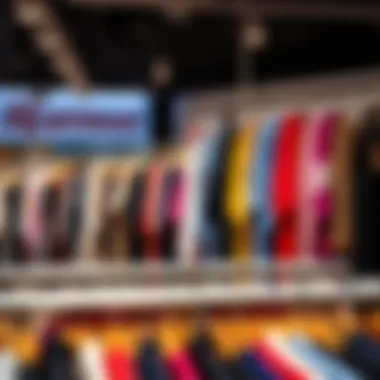

The color palette is vibrant yet not overwhelming, striking a balance that caters to youthful aesthetics while ensuring readability. It’s a user-friendly site that requires minimal scrolling and searching.
Product Range and Availability
Romwe prides itself on offering a staggering variety of options. Whether you're hunting for the latest streetwear trends or items that reflect a more classic style, you’re likely to find something that suits your taste.
- Constantly Updated Inventory: With new items rolling in frequently, the selection never feels stale. This aspect keeps shoppers returning, eager to discover what’s next. Romwe effectively employs the principles of fast fashion, releasing collections that align with the latest trends without lag.
- Inclusivity Across Styles: The product range also caters to various preferences, from casual wear to something more chic, ensuring that there's something for everyone. This broad appeal helps Romwe connect with a diverse audience, enhancing its market presence.
One must note, however, that while the inventory is extensive, the availability of specific items can vary. Popular products often sell out quickly, which can frustrate customers.
Shipping and Return Policies
Lastly, the logistics of shopping—specifically shipping and returns—play a significant role in the overall experience. Romwe's policies reflect an understanding of the millennial and Gen Z shopper who values convenience.
- Shipping Options: Romwe offers different shipping methods that cater to the urgency of consumer needs. Standard shipping is typically free on orders over a certain amount, which can effectively minimize the overall cost for the shopper.
- Return Process: The return policy is relatively straightforward. Customers have a set period in which they can return items if they don't meet expectations. A hassle-free return process encourages buyers to make purchases without the fear of getting stuck with a product they don’t love.
"A transparent return policy can be the difference between a one-time buyer and a loyal customer. Romwe clearly understands this notion."
The Fast Fashion Model
The fast fashion model in retail has become a focal point of discussion in the contemporary fashion landscape, primarily due to its accelerated production cycles and ever-evolving trends. This article will peel back the layers of this model, explaining not just what fast fashion is but how it fundamentally reshapes consumer behavior and brand strategies, specifically for a company like Romwe.
The Concept of Fast Fashion Explained
Fast fashion refers to the process of rapidly designing, producing, and selling clothing that reflects the latest trends at an affordable price. The alignment of design and production timelines has drastically shortened, allowing companies to catch the wave of trends as they emerge. This model thrives on the belief that fashion is transient and that consumers will eagerly purchase new styles, often at an impulsive pace.
Benefits of the fast fashion model include:
- Quick response to market demands.
- Affordability for the consumer, enticing them to buy more.
- Increased variety in wardrobe choices, which caters to the diverse tastes of different demographics.
However, this model isn’t without its challenges. The repercussions include sustainability concerns, as rapid production often leads to waste and unethical labor practices. Understanding these dualities helps to illustrate the complexities that Romwe, among other brands, navigate in the fashion world.
Romwe's Approach to Fast Fashion
Romwe thrives in the fast fashion space by implementing a strategy focused on rapid design execution and minimal costs. The company takes inspiration from runway looks and street style, often translating these trends into accessible pieces that resonate with the consumer base. Their ability to introduce new items on the website frequently, sometimes even weekly, keeps the catalog fresh and engages a fashion-forward audience.
Additionally, Romwe employs:
- Data-driven analytics to gauge consumer interest, allowing for a more focused product offering.
- Social media engagement, harnessing platforms like Instagram and TikTok to shape trends and inform customers about the latest arrivals.
In this competitive arena, Romwe’s model prioritizes not only speed and cost but also the importance of storytelling in marketing its products. Influencer partnerships play a crucial role, as they bridge the gap between brand offers and consumer interests.
"Fashion is a way to communicate, a way to tell your story, and Romwe seems to harness this idea beautifully in the fast-paced market."
Through this lens, one can appreciate how Romwe uniquely positions itself as not just a lock on fast fashion but a platform that seeks to connect closely with its consumer base, driving its relevance in a modern, digitally-savvy world.
By merging speed with strategic insight, the brand shapes not only its own future but also contributes to the greater narrative of fast fashion in our society.
Customer Perceptions and Reviews
Customer perceptions and reviews serve as a barometer for any business, particularly in the fast fashion sphere, where brands like Romwe operate. This section dives into the significance of understanding customer sentiments, highlighting how reviews can influence purchasing decisions and overall brand reputation. Feedback from customers doesn’t just reflect personal experiences; it creates a wider narrative about the brand’s reliability, quality, and value.
Analyzing customer perceptions can also help Romwe identify which products resonate with the market and which fall flat. Effective feedback loops are essential for brands to adapt and improve. Missteps in this domain may lead to declining sales and customer trust, turning fervent fans into disenchanted shoppers with a mere click of a button.
Analyzing Customer Feedback
Feedback is like a double-edged sword for Romwe. Positive reviews can drive sales, while negative ones can tarnish its image faster than a wink. The company has been known to harness digital platforms where customers share their thoughts, from social media to dedicated review sites like Reddit.
When examining customer reviews, certain key metrics come to light:
- Quality of Product: Are the materials as good as advertised? Do the sizes run true? These questions occupy customers’ minds when they provide ratings.
- Customer Service: How did Romwe handle inquiries, returns, or complaints? Fast and friendly responses can elevate the shopping experience.
- Pricing: In fast fashion, a brand’s ability to deliver value remains paramount. Are customers satisfied with what they receive for their money?
By parsing through these focal points, Romwe can pinpoint success stories and areas that call for improvement. A deep understanding of feedback allows the brand to engage with its community more effectively, creating a cycle of continual refinement.
Brand Loyalty and Retention
The relationship between Romwe and its customers isn't merely transactional; it often evolves into a deeper connection rooted in loyalty. Look no further than satisfying a customer’s needs—it’s a simple yet powerful way to foster brand retention. Many shoppers return to brands that make them feel valued and understood.
One vital aspect of building loyalty for Romwe lies in the following:
- Personalization: Tailoring experiences and offers based on buying habits encourages repeat purchases. People love businesses that know what they like.
- Engaging Content: Keeping customers informed through newsletters or social media posts about new trends may entrench their ties to the brand.
- Loyalty Programs: Incentives that reward frequent customers reinforce commitment and transform casual buyers into brand ambassadors.
The journey of customer loyalty is both delicate and essential. If Romwe can navigate this path while addressing concerns highlighted in reviews, it creates a formidable bond with its customer base. In an industry that thrives on trends and newness, customer retention becomes a golden ticket to sustained success.
Ethical Considerations in Fast Fashion
Understanding the ethical implications of fast fashion is central to evaluating brands like Romwe. These concerns are not just noise but resonate deeply within the fabric of contemporary society. With the explosion of online shopping—where convenience and trends often overshadow sustainability—there’s a pressing need to address the ramifications of these purchasing choices. This section navigates the murky waters of ethics in fashion, spotlighting sustainability, labor practices, and consumer responsibility.
Sustainability Issues in the Industry
The fast fashion industry faces heavy scrutiny regarding its environmental impact. From production to disposal, the journey of clothing leaves a significant ecological footprint. Here are some key issues:
- Overproduction: Brands often churn out vast quantities of clothes to keep up with ever-changing trends. This leads to immense waste when unsold items end up in landfills.
- Resource Depletion: The production process, whether it’s cotton farming or synthetic material creation, consumes considerable water and energy. The continuous demand exacerbates resource depletion, impacting communities around the globe.
- Chemical Waste: The dyeing and finishing processes release harmful chemicals into waterways, endangering aquatic life and local populations.
These unsustainable practices stand in stark contrast to the growing awareness among consumers regarding environmental issues, thus presenting a challenge for brands to rethink their operations.
Romwe's Efforts Toward Sustainability
While Romwe is often categorized alongside traditional fast fashion brands, it has initiated steps to address some of the sustainability concerns inherent to its business model. Here are a few notable efforts:
- Sustainable Collections: Romwe has started to roll out collections focused on eco-friendly materials. These lines often use organic cotton or recycled fabrics, appealing to a more environmentally conscious demographic.
- Partnerships for Environmental Good: The brand collaborates with various organizations committed to environmental initiatives, aiming to offset some of its carbon footprint. Such partnerships not only enhance their public image but also help in raising awareness.
- Transparency Measures: Romwe is beginning to communicate more openly about its sourcing and production practices. By releasing information regarding their supply chains, the company seeks to build trust with its customers.
"The journey towards sustainability is ongoing, and brands like Romwe are slowly but surely altering course."
The Role of Social Media in Fashion Marketing
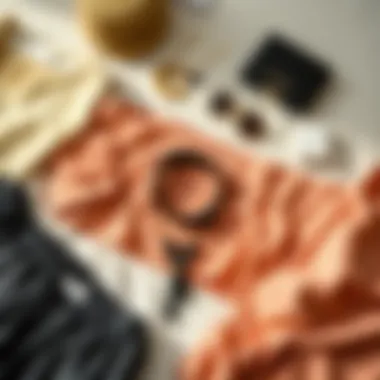

In today’s digital era, the influence of social media on fashion marketing cannot be overstated. Platforms like Instagram, TikTok, and Pinterest have transformed how brands engage with consumers, providing unique opportunities to reach wider audiences. For Romwe, harnessing the power of social media isn’t just a strategy; it’s become a cornerstone of their marketing approach. This section unwraps how Romwe utilizes social media, shedding light on vital components like influencer collaborations and user-generated content, and the myriad benefits these methods bring.
Influencer Collaborations
Influencer collaborations have become pivotal in fashion marketing, offering brands an authentic way to connect with potential customers. Romwe recognizes this worth and has developed partnerships with various influencers, ranging from micro-influencers to high-profile figures.
By aligning with fashion-forward individuals, Romwe can tap into niche markets and gain credibility among their followers. Here’s why these partnerships are essential:
- Authenticity: Influencers have built trust with their audience. Their recommendations often carry more weight than traditional advertisements.
- Targeted Reach: Brands can reach specific demographics by selecting influencers whose followers align with their target market. For instance, an influencer known for street style might attract younger consumers looking for trendy pieces.
- Content Creation: Collaborations yield a wealth of engaging content. Influencers present products in relatable settings, making them desirable.
"Influencer marketing is more than just a trend; it's a powerful communication channel that shapes consumer perceptions and drives purchase decisions."
As a result, Romwe has managed to leverage these partnerships not just for promotions but for creating a community of brand advocates who share their experiences and styles on social media. This not only boosts visibility but also fosters a sense of loyalty among customers.
User-Generated Content
User-generated content (UGC) plays a vital role in modern fashion marketing. Romwe actively encourages customers to post their outfits on social media, thus transforming everyday shoppers into brand ambassadors. The beauty of UGC lies in its relatability and authenticity. Here’s how Romwe benefits from this approach:
- Social Proof: When potential customers see real people wearing products, it boosts credibility and trust. Shoppers tend to relate more to their peers than to polished magazine ads.
- Engagement: Brands encouraging their audience to participate creates a sense of belonging. Romwe often features customer photos on their official social media pages, creating an interactive community.
- Cost-Effective Marketing: Unlike traditional marketing strategies that can be expensive, leveraging UGC is both budget-friendly and effective. Customers essentially become part of the marketing strategy.
Through strategic use of social media, particularly influencer collaborations and user-generated content, Romwe continues to cement its presence in the fast fashion landscape. Their grasp of these concepts not only enhances brand visibility but also creates deeper connections with the audience, ensuring they remain at the forefront of modern fashion.
Trends in Online Fashion Retail
The landscape of online fashion retail has shifted dramatically over the past decade, with changes driven by technology, consumer preferences, and market dynamics. Understanding these trends is essential for players in the fashion industry, particularly for brands like Romwe that navigate this bustling e-commerce environment. As we explore these trends, we illuminate their relevance in understanding Romwe's operational strategies and their influences on modern fashion consumption.
E-commerce Growth Patterns
The expansion of e-commerce has reshaped how we perceive and engage with fashion. Here’s a closer look at some of the significant growth patterns:
- Mobile Shopping: The rise of smartphones has led to a significant increase in mobile shopping. Many consumers prefer browsing and purchasing through apps or mobile sites. Romwe capitalizes on this trend by optimizing its website for mobile devices, offering a seamless shopping experience.
- Social Commerce: With platforms like Instagram, Facebook, and TikTok, social media has evolved from a communication tool to a shopping haven. Brands now engage consumers directly through targeted ads and influencer partnerships. Romwe effectively utilizes social media to market its products to a younger audience, encouraging impulse buys through visually appealing posts and stories.
- Personalization and AI: Tailored shopping experiences have become a cornerstone of online retail. Utilizing data analytics, Romwe tracks user behavior to offer personalized recommendations, making the shopping journey feel more curated. This approach not only enhances customer satisfaction but also increases chances of conversion.
"In understanding consumer behavior, it’s clear that personalization can significantly influence purchase decisions, making shoppers feel valued and understood."
- Sustainability Practices: With the growing awareness of environmental issues, many consumers are now more conscious of where they shop and the practices of brands. Fast fashion retailers are often criticized for their environmental impact, thus creating a push towards sustainable practices. Romwe faces this challenge but also sees it as an opportunity to redefine its image by adopting sustainable methods in its operations.
Future Forecasts for Online Retail
As we gaze into the crystal ball, what does the future hold for online fashion retail? Here are several forecasted trends that will shape the industry:
- Augmented Reality (AR) Technology: The integration of AR in the shopping experience will likely become commonplace. Customers may soon try items virtually before buying, helping to mitigate returns stemming from sizing issues.
- Global Expansion: The industry is anticipated to witness more brands, including Romwe, expanding into international markets. However, success will require an understanding of local consumer preferences and styles.
- Integration of Virtual Shopping Events: Online fashion shows and live shopping events may soon gain traction as they offer a more interactive way for consumers to engage with products and brands.
- Blockchain for Transparency: With a growing demand for transparency in supply chains, blockchain technology could play a significant role. This would allow consumers to verify product origins and the ethical practices of brands.
In summary, the trends in online fashion retail provide a vital compass for brands like Romwe, guiding them through an ever-evolving market landscape. By keeping an ear to the ground regarding these trends, Romwe can position itself strategically to meet the demands of modern consumers and thrive in the competitive fashion retail environment.
Comparative Analysis with Other Retailers
A comparative analysis is crucial when evaluating Romwe and its standing in the online fashion retail landscape. Such an analysis provides insights into how Romwe aligns—or diverges—from its competitors, allowing stakeholders and consumers to make informed choices. In today’s hyper-competitive market, understanding what sets a retailer apart is essential, not only for branding but also for strategic decision-making and consumer preferences.
The comparison between Romwe and other retailers highlights several key elements:
- Product Variety: Romwe offers a broad range of products akin to other fast fashion retailers like Shein and Forever 21, yet it often aims to deliver funky, standout items that appeal to a younger audience seeking distinctiveness.
- Pricing Strategies: Pricing is a significant factor in fast fashion. Romwe employs aggressive pricing, frequently engaging in flash sales to attract bargain-hunters. This tactic mirrors the strategies of competitors, but Romwe’s use of discounts can at times lead to questions regarding product quality.
- Online Experience: The website’s usability and design play a critical role in consumer attraction. While Romwe’s site is visually approachable and easy to navigate, competitors like ASOS may provide a richer browsing experience due to advanced filtering and user interface enhancements.
"Understanding the strengths and challenges of Romwe in comparison to its rivals gives insight into the dynamics of fast fashion, impacting everything from marketing to consumer choices."
Romwe vs. Competitors
When comparing Romwe to its competitors, the variations in brand perception, customer loyalty, and product offerings become particularly evident. For instance, Zara and H&M concentrate on a more classic fashion approach, focusing on semi-annual collections and timeless pieces. In contrast, Romwe thrives on transient trends, where styles might come and go with the season—or even the week.
- Market Reach: While global presence is vital, Romwe has capitalized on its online-first approach, reducing overhead costs typically associated with brick-and-mortar locations. This gives Romwe a competitive edge, enabling it to reach customers in regions where physical stores might not thrive.
- Target Audience: Romwe primarily focuses on Gen Z consumers, leveraging social media to maintain relevance with trends that this demographic cherishes. In contrast, competitors like Uniqlo target a broader age range with a focus on comfort and practicality.
Market Positioning Strategies
The market positioning strategies of Romwe are essential to its competitive edge. In a saturated market, differentiation is key. Romwe positions itself through unique marketing tactics:
- Social Media Engagement: Utilizing platforms like Instagram and TikTok, Romwe has engaged influencers to showcase their products, creating a community feel and encouraging hashtag challenges, fostering organic visibility.
- Trend Responsiveness: Romwe’s rapid ability to adapt to fashion trends sets it apart from more traditional retailers. By investing in trend forecasting and actively monitoring what’s popular on platforms like Pinterest and social media, Romwe efficiently curates its product line.
- Customer-Centric Promotions: The frequent sales and promotional campaigns, including cross-promotions with influencers, play a crucial role in enhancing visibility and driving sales.
In summary, the comparative analysis yields significant insights into how Romwe operates within the fast fashion sector. By dissecting its strategies against the backdrop of competitors, one can glean the complexities involved in consumer behavior, marketing influence, and the broader dynamics of the retail landscape.
Consumer Behavior in Fast Fashion
Understanding consumer behavior in the fast fashion landscape is crucial for comprehending the broader implications of modern retail dynamics. This segment delves into the motivations behind purchases and the patterns that follow after the transaction. Both facets are vital to Romwe’s operational strategy and influence marketing approaches as well as stock management decisions.
Motivations for Purchase
When consumers shop at fast fashion retailers like Romwe, several motivations drive their decisions. The allure of trendy items at affordable prices is primary. Many shoppers, particularly younger ones, feel a constant pressure to keep up with fleeting fashion trends. Social media plays a pivotal role here. Platforms like Instagram and TikTok often dictate the styles that are in vogue, fostering a sense of urgency among consumers to acquire similar pieces quickly.
Additionally, the perception of value cannot be understated. Fast fashion brands typically offer a wide range of clothing at competitive prices, which appeals to budget-conscious shoppers. It’s not just about cost; it's also about getting more for less. This leads to a cumulative psychological benefit, making consumers feel savvy and wise about their choices.
"In the realm of fast fashion, the purchase isn’t just transactional; it’s a gateway to social acceptance and self-expression."
The ease of online shopping also plays a significant role. With just a few clicks, shoppers can explore vast inventories without the hassle of traditional retail settings. This convenience taps into the instant gratification ethos that pervades modern consumerism. It’s about time, effort, and creating a satisfying shopping experience.
Factors such as limited-time promotions and countdown sales also contribute to a fear of missing out, pushing shoppers to rush into purchases they might later reconsider. This highlights the emotional component of buying behavior, heavily influenced by marketing strategies that emphasize scarcity and exclusivity.
Post-Purchase Behavior
After making a purchase, the behavior exhibited by consumers is equally telling. Post-purchase, buyers often reflect on their choices — a moment of euphoria can quickly shift to buyer's remorse, especially if the product does not meet expectations. This creates a cyclical pattern that companies need to address.
Romwe, like many fast fashion retailers, has a robust return policy aimed at mitigating any dissatisfaction. The ability to return items easily can influence customers' willingness to buy, hence playing a critical role in their overall shopping experience. The emphasis here is on reducing perceived risk; if shoppers feel confident that they can rectify a poor choice, they are more inclined to purchase without reservation.
Moreover, the post-purchase stage is a ripe opportunity for brand engagement. Social media platforms serve as a channel where customers often share their experiences, whether positive or negative. A satisfied buyer might flaunt their new outfit online, generating organic marketing. On the flip side, a negative experience quickly becomes a public forum for complaints, impacting the brand’s reputation.
The Influence of Fashion Cycles
The fashion landscape is undeniably shaped by a series of cycles that dictate trends, consumer behavior, and ultimately, retail strategies. Understanding fashion cycles becomes crucial for any brand, including Romwe, as it allows them to anticipate market shifts and respond effectively. In this section, we’ll explore how these cycles influence the fast fashion realm, particularly through Romwe's approach.
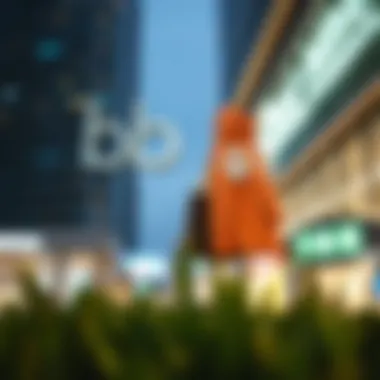

Understanding Fashion Trends
Fashion trends can be visualized as waves that rise and fall, capturing the zeitgeist of various ages and demographics. Each wave reflects shifts in cultural moods, technological advancements, and social developments. For Romwe, staying attuned to these trends is of utmost importance. Through a keen understanding of emerging styles, the brand can design collections that resonate with the current pulse of society.
For instance, the resurgence of Y2K fashion—a style that thrived in the early 2000s—has found its way into Romwe’s latest offerings. By absorbing and adapting to such trends, Romwe enhances its appeal to a younger audience that craves nostalgia combined with modern aesthetics. Here are some key elements that elaborate on how trends shape consumer preferences:
- Cultural Influences: Global events or movements can ignite trends, as seen during post-pandemic recovery phases where comfort became essential in fashion choices.
- Seasonality: Each season demands a fresh look. Romwe’s agility allows them to pivot quickly, releasing seasonal lines without missing a beat.
- Digital Impact: Social media channels like Instagram and TikTok have democratized fashion trendsetting. Romwe leverages these platforms, showcasing user-generated content to stay relevant.
Impact on Inventory and Sales
The cyclical nature of fashion not only dictates what's considered stylish but also has significant repercussions on inventory and sales strategies for brands like Romwe. The ability to anticipate which trends will gain traction can determine whether a product line flops or thrives.
When a trend emerges, Romwe must act swiftly to ramp up production, ensuring that popular items are in stock before demand peaks. This agility leads to increased sales but also poses challenges, such as:
- Overstock Risk: Misjudging a trend's longevity can lead to excess inventory, forcing the brand to mark down prices to clear stock.
- Supply Chain Management: Speedy production requires adept coordination with suppliers. If trends shift unexpectedly, it might leave the brand with surplus goods and tangled supply chains.
Technological Innovations in Fashion Retail
In the rapidly evolving world of fashion retail, technological innovations play a fundamental role. These advancements not only streamline operations but also redefine how consumers interact with brands. Particularly for Romwe, a leader in the fast fashion sector, embracing technology has proven essential to remain competitive and relevant. From the way customers browse to how they purchase, technology has transformed the experience into something unique and engaging.
E-commerce Technologies
E-commerce technologies form the backbone of online retail. For Romwe, this is crucial. With the rise of digitalization, the traditional shopping experience has adapted. Some of the key technologies that impact Romwe include:
- Mobile Optimization: Given that a vast majority of shoppers use mobile devices for shopping, Romwe's website and app are designed to be mobile-friendly. This eases navigation and allows for a smoother shopping experience.
- Augmented Reality (AR): While still in its infancy within the industry, AR provides customers with the ability to visualize how items would look on themselves or their surroundings before purchase. This could lead to a better decision-making process, reducing return rates.
- Chatbots and Virtual Assistants: These tools assist shoppers in real time, answering questions and guiding them through the buying process. This technology helps in retaining customers and ensuring a satisfactory shopping journey.
"The use of e-commerce technologies has not only improved user experience but has also driven sales growth for online retailers like Romwe."
The ability to leverage these technologies allows Romwe not only to attract but also to retain customers, thus fostering brand loyalty.
Data Analytics and Consumer Insights
The importance of data analytics can't be overstated in the realm of fashion retail. For a brand like Romwe, understanding consumer behavior through data provides crucial insights into preferences and buying habits.
Some of the aspects worth noting include:
- Personalized Marketing: By analyzing customer data, Romwe can tailor marketing messages to specific segments of their audience. This targeted approach improves the chances of conversion as customers receive offers that are relevant to their interests.
- Trends Analysis: Data analytics allows Romwe to spot trends before they become mainstream. For instance, if a particular style gains traction on social media, Romwe can quickly adapt their inventory to include similar products, thus ensuring they stay ahead of the curve.
- Inventory Management: Utilizing analytics helps Romwe optimize stock levels and reduce overproduction. For a fast-fashion retailer, this is vital not only for profitability but also for minimizing waste, thus addressing some ethical concerns surrounding fast fashion.
In summary, technological innovations are more than just a trend; they are the lifeblood of contemporary fashion retail. Romwe's adept use of e-commerce technologies and data analytics not only enhances the customer’s shopping experience but also serves as a critical component in their ongoing success within a fiercely competitive market.
Global Impact of Romwe Shop
The significance of Romwe in the global fashion landscape cannot be understated. Known for its rapid rise in the fast fashion market, Romwe has become a cornerstone for many consumers seeking trendy apparel at budget-friendly prices. This section aims to unpack the various dimensions of Romwe's international presence, shedding light on the dynamics that contribute to its ongoing success.
Romwe's International Reach
Romwe has strategically positioned itself on the global map of online retail, catering to a diverse audience across different continents. The brand has established a strong foothold not just in Western markets but also in regions like Asia, Europe, and Latin America.
- Global Distribution: With its warehouses located strategically around the globe, Romwe ensures faster shipping options, making shopping more convenient for its international customers. This creates a more favorable shopping experience than many traditional retailers can offer.
- Language Accessibility: By localizing its website in various languages, Romwe allows shoppers from different linguistic backgrounds to navigate easily. This inclusivity expands Romwe's reach, making it relatable to a wider demographic.
- Customization: Romwe leans into trends prevalent in specific areas, curating collections that resonate with local tastes and cultural nuances. This localization strategy enhances customer loyalty and drives sales significantly.
"Globalization has enabled brands like Romwe to capture a substantial market share by adapting their methods to meet diverse consumer needs in real time."
Cultural Impacts on Fashion Consumption
The cultural influences that Romwe embodies are a reflection of the broader trends shaping fashion consumption today. As the brand caters to a youthful and digitally savvy audience, its approach to fashion is an amalgamation of cultural elements that significantly affect consumer behavior.
- Fast Fashion and Cultural Trends: Romwe is adept at identifying and leveraging social media trends. By quickly transforming these trends into purchasable items, Romwe keeps its finger on the pulse of today's cultural zeitgeist. The instantaneous nature of fashion cycles is reshaping consumer expectations, with shoppers now wanting to see new collections appear almost overnight.
- Diversity in Styles: By offering diverse styles that reflect different cultures, Romwe has created an inclusive shopping environment. This diversity influences how individuals express their identities through fashion, making it a more personal and localized experience. It acknowledges different cultural heritages and preferences in its collections, allowing users to find pieces that resonate personally.
- Social Media Buzz: Platforms like Instagram, TikTok, and Pinterest have a significant influence on how Romwe engages with its audience. The brand expertly capitalizes on user-generated content, where customers showcase their purchases in various cultural contexts, thus widening its appeal and affirming its place in modern fashion dialogues.
Romwe’s global outreach and cultural sensitivity illustrate how modern fashion consumption is no longer about just clothing; it's about connection, representation, and identity. As Romwe continues to evolve, its impacts on global fashion trends will likely remain profound.
Future Directions for Romwe
As we peer into the horizon of fashion retail, the outlook for Romwe is both promising and intricate. Being a significant player in the fast fashion realm, understanding the future directions for Romwe enables stakeholders—designers, marketers, stylists, and students—to pick up on nuances that could dictate market trends down the line. This section will shed light on potential growth areas for Romwe, as well as strategic recommendations that can bolster its position in an ever-evolving landscape.
Potential Growth Areas
Romwe, like any vibrant entity in a bustling marketplace, must consistently evolve to meet the shifting desires of consumers while also internalizing global trends. Here are some areas where growth seems ripe:
- Sustainable Practices: There’s no denying that customers are increasingly gravitating towards brands that prioritize sustainability. Romwe could delve deeper into eco-friendly fabrics and ethical sourcing. This could attract a newer, more environmentally-conscious consumer base.
- Expansion into New Geographies: The potential for tapping into emerging markets remains largely unexplored. Countries in Africa and Southeast Asia present fertile ground for fashion expansion, with a youthful demographic eager for trendy apparel.
- Enhanced Customer Personalization: Leveraging technology to offer personalized shopping experiences can set Romwe apart. By utilizing data analytics to understand purchasing patterns, Romwe could tailor recommendations and create exclusive offers, fostering deeper connections with customers.
- Collaboration with Ethical Brands: Partnerships with established ethical brands could enhance Romwe's credibility. This way, they can bridge the gap between affordable fashion and responsibility, resonating well with a broader audience.
These growth areas not only align with market demands but also speak to an ethical evolution that the fashion industry is undergoing.
Strategic Recommendations
Developing a solid strategy goes beyond flashy campaigns. Here’s a shortlist of tactical moves that Romwe could consider:
- Invest in Transparent Supply Chains: Building trust with consumers starts with transparency. Providing detailed information about sourcing, manufacturing, and labor practices may yield both loyalty and increased sales.
- Focus on Building a Community: By fostering a community through social media platforms and engaging customers in discussions regarding fashion trends, Romwe can create a sense of belonging that encourages loyalty and drives repeat purchases.
- Innovate with Technology: Enhancing website user experience through augmented reality could allow customers to virtually 'try on' clothes. This tech-savvy approach could attract younger audiences and reduce return rates.
- Seasonal and Limited-Time Collections: Introducing seasonal themes and collaborations with local artists can create buzz and urgency among shoppers, making them feel part of an exclusive club.
- Strengthen Return Policies: An accommodating return policy could significantly enhance customer trust. Clear guidance, easy returns, and expedited processes can help ease any hesitation customers might have.
“In the fast-paced world of fashion, the emphasis on adaptation and consumer connection is key to survival.”
By integrating these recommendations, Romwe has the potential to not only retain its existing customer base but also to expand its influence in the dynamic landscape of modern fashion. With forward-thinking strategies in place, the brand can confidently march into the future equipped for success.
End
In this fast-paced digital age, understanding the intricacies of Romwe Shop and its significant role in contemporary fashion is more pertinent than ever. This article has traversed various dimensions of Romwe, from its strikingly versatile collection to the potential influences of its business model on both consumers and the fashion industry at large. Exploring this topic is crucial not only for fashion enthusiasts but also for industry professionals who seek to navigate the evolving landscape of e-commerce and fast fashion.
Recap of Key Insights
Throughout our discussion, several pivotal insights have emerged:
- Fast Fashion Dynamics: Romwe epitomizes the fast fashion model, offering trendy apparel at budget-friendly prices, capturing the essence of instant gratification that modern consumers demand.
- Target Demographics: The brand primarily appeals to younger generations, particularly millennials and Gen Z, whose shopping habits lean heavily towards online platforms and social media engagement.
- Sustainability Concerns: Despite its growth and popularity, Romwe faces scrutiny regarding environmental sustainability and ethical practices in manufacturing. The shift towards eco-friendliness in fashion is increasingly pressing, pushing brands to reconsider their operational frameworks.
- E-commerce Trends: The rise of online shopping has redefined retail, with Romwe making significant strides in technology to enhance customer experiences, from user-friendly website design to incorporating data analytics for personalized marketing.
- Global Reach: With a robust international presence, Romwe has managed to adapt its offerings to suit diverse cultural tastes, highlighting the increasing globalization of fashion consumption.
These elements intertwine and showcase how Romwe represents both the opportunities and challenges within modern fashion retail.
The Future of Fast Fashion in eCommerce
Looking ahead, the future of fast fashion remains uncertain yet filled with potential. As e-commerce continues to expand, Romwe must innovate to stay relevant.
- Sustainability Initiatives: Adopting more sustainable practices could redefine Romwe's place in the market. As consumer demand for eco-conscious options grows, the company may find that transparency in sourcing materials and ethical production will not only meet customer expectations but also enhance brand loyalty.
- Technology Integration: The incorporation of advanced technologies, such as augmented reality and artificial intelligence, could revolutionize how customers shop and interact with the brand. Offering virtual fitting rooms or personalized recommendations could enhance the shopping experience dramatically.
- Expanding Product Lines: Introducing more categories, like luxury or handmade items, could diversify the brand’s portfolio. This expansion might draw in consumers looking for unique pieces, thus broadening Romwe's appeal beyond fast fashion essentials.
- Marketing Strategies: The power of social media influencers will likely continue to shape fashion e-commerce. Collaborations with a diverse array of influencers can help Romwe resonate with various audience segments, solidifying its position in the digital marketplace.
- Global Trends: Keeping a finger on the pulse of international fashion trends will be essential. As different cultures continually evolve their style, Romwe can benefit from customizing its offerings to meet the unique tastes and preferences of consumers worldwide.
Ultimately, while challenges abound, the potential for innovation and growth within the realm of fast fashion and e-commerce is substantial. As Romwe adapts to these shifting tides, its impact on modern fashion will undoubtedly persist, providing a case study in agility and evolution in an ever-changing industry.










